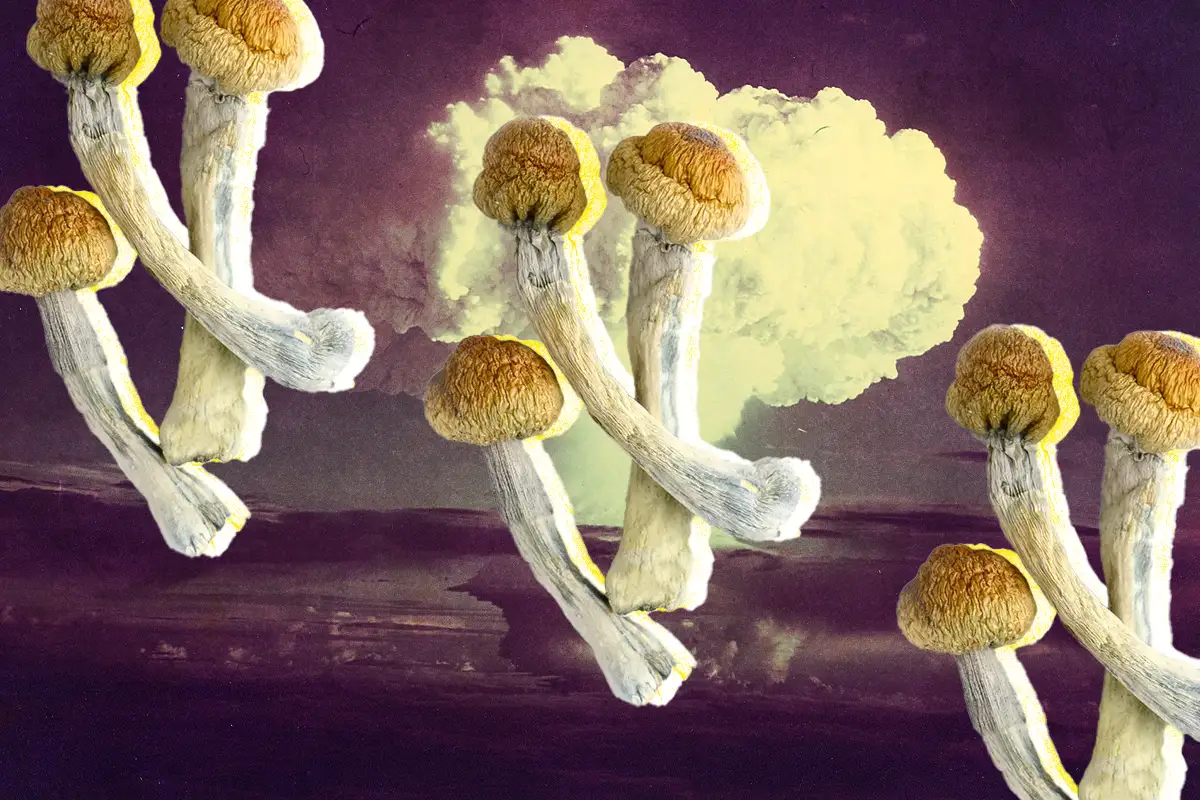What happens when you crossbreed three mushrooms that are already the result of hybridization? It’s a very 2024 question. The crossbreeding of psychedelic mushrooms has gone into overdrive as underground mycologists attempt to birth shrooms of ever-increasing potencies and alleged uniqueness.
Enter the Trinity mushroom — a Psilocybe cubensis trifecta of the notorious “Penis Envy,” the little-known “Aztec God” and “Tidal Wave,” which itself is a hybrid of B+ and Penis Envy, also created by Trinity’s father, Doma Nunzio. He is a mycologist who founded MagicMyco, a mushroom genetics research company, and Cultivar Cup organizer.
Over the last couple of years, hype has built around Trinity after its 2017 genesis. Online dispensaries wax lyrical about its “intricate lineage” and “multi-strain ancestry [that] imparts an impressive potency which truly justifies its name, Trinity.” Another vendor makes the unlikely declaration that the strain can “open up hitherto unattainable states of consciousness.”
I asked Nunzio about the sensational claims being made about his mushroom. He says there is “maybe something to it” but that more research data is needed. “I can say from personal experience, it’s not as dark as some others,” Nunzio says.
READ: Combining Ozempic with Psychedelic Compound May Treat Diabetes
Trinity contains higher levels of the lesser known alkaloids, like baeocystin, rumored to have an anti-anxiety effect, he adds. “It seems to always have a little bit more of the minor alkaloids like baeocystin, which seems to give us some kind of entourage effect which we are still investigating.”
So where did the name come from? “It also means the Holy Spirit, but the main reason was for the nuclear blast,” Nunzio says, referring to the July 1945 US Army nuclear weapon test of the bomb that was later dropped on Nagasaki, killing a third of the city’s inhabitants. “Trinity was just the bomb.” The resultant mycelial creation from the three-way mushroom cross was so “multinucleated” that “it exploded on everything you put it on.”
Trinity – which bears a striking resemblance to its Penis Envy ancestor – has certainly entered the myco-copeia of psilocybin fungi sold at underground dispensaries. “I’m really happy that it’s making waves,” Nunzio says. “It’s affecting people’s lives. It’s touching people spiritually and cultivators enjoy growing it. It’s another one of my series in the Tidal Wave family.”
To create Trinity, Nunzio crossed the spores of Tidal Wave, a notoriously unstable hybrid known for a variety of weird mutations, with Penis Envy – which has its own fascinating origin story. The hybrid was birthed with a little help from monocultures placed on antibiotic agar, a gelatinous substance derived from seaweed, which is used to germinate spores and culture mycelium. He also crossed Penis Envy spores with Aztec God, and then he crossed his two new liquid mushrooms together before putting the resultant solution in a jar.
“It was the first three-way one I did, and the mycelium would explode on grains and substrates,” he says. “I let it colonize that jar for six months before we brought it out and fruited it for the first time.” It was far along its life cycle, and all of its nutrients were exhausted, Nunzio adds. “It was very multinucleated [ready to fruit], so it would just pretty much explode as soon as you put it onto anything.”
Soon enough, Trinity burst onto the mushroom scene, though it has been overshadowed by its forefathers. In 2021, at the first Oakland Hyphae Psilocybin Cup, Tidal Wave, one of the strongest strains or species ever tested, came first place in the Cubensis category, bestowing significant credibility on Nunzio.
“This isn’t a day for ego cleansing (we can do that tomorrow, lol) ; no, pat yourself on the back cause today is a day to rejoice and celebrate for we worked hard and are on a team that has WON the first ever psilocybin cup! Tidalwave taking the cup!” read the Magic Myco blog. “TIDALWAVE has been one of the most controversial and highly cultivated and reworked strains in the CUBENSIS community since its inception by Dom A. during Spring 2017.”
Trinity, however, finished 24th in the cup, and not everyone is party to the hype. “I don’t personally think it’s anything super special myself,” says one mycology expert who did not want to be named. “Its constituent parts are arguably better, honestly. Sometimes, hybridizing stuff doesn’t always yield more potency. There’s nothing wrong with it but it’s overhyped.” Mushroom aficionados will debate whether the hallmark of a good mushroom is potency, and Nunzio did point to its apparent higher levels of other alkaloids.
The anonymous mycology expert, however, questioned whether a mushroom can truly be a three-way hybrid. “Even if you’re doing it between different Cubensis varieties, it would take multiple hybridization events to achieve what they’re saying but the end product wouldn’t be three things together,” he says. “It’s just a weird way to describe it. Suffice it to say that the way I view it is just another hybrid.”
Still, of all the mushrooms out there, one psilocybin chocolate bar business uses Trinity as their sole fungus. “It’s consistent, it’s homogenous,” says the owner, who did not want to be named due to the illegality of his business, and does not know Nunzio personally. “We use it exclusively in our chocolate and have for years. It’s easy to grow and doesn’t require much maintenance.” Other mushrooms have issues with consistency of quality and potency, but Trinity is a “high-yielding” strain, he says. “I hate to say it, and I don’t mean this as a criticism, but it’s like the Blue Dream of mushrooms.”
Blue Dream is a cannabis strain that was extremely popular — ubiquitous, even — a decade ago. “It was a good producer,” he says. “It smelled good. Looked good. Tastes good. It had a great effect on [some] people. It kind of covers all of those bases.” He also described it as “trendy” — but should a mushroom be trendy?
DoubleBlind is a trusted resource for news, evidence-based education, and reporting on psychedelics. We work with leading medical professionals, scientific researchers, journalists, mycologists, indigenous stewards, and cultural pioneers. Read about our editorial policy and fact-checking process here.
DoubleBlind Magazine does not encourage or condone any illegal activities, including but not limited to the use of illegal substances. We do not provide mental health, clinical, or medical services. We are not a substitute for medical, psychological, or psychiatric diagnosis, treatment, or advice. If you are in a crisis or if you or any other person may be in danger or experiencing a mental health emergency, immediately call 911 or your local emergency resources. If you are considering suicide, please call 988 to connect with the National Suicide Prevention Lifeline.
DoubleBlind Mag Read More


